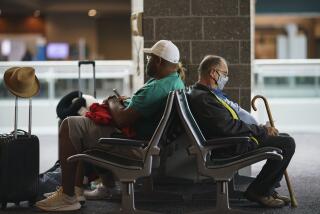Increasing the Odds of Surviving an Air Crash
- Share via
Airplane travel is safer than driving, as statistics from the National Transportation Safety Board suggest.
Eight hundred people died in 1993 in civil air accidents in the United States or in accidents involving U.S.-registered aircraft, according to NTSB statistics. Of those 800 deaths, one occurred on a major scheduled airline, and it was not a passenger but a ground crew member struck by a propeller. Of the other 799 deaths, 715 were on private (general aviation) aircraft, according to NTSB spokeswoman Charlotte Casey.
By comparison, 42,000 people died last year in motor vehicle accidents, according to the National Safety Council.
Even so, accidents such as the recent American Eagle crash in northern Indiana that killed 68 can make even frequent fliers anxious.
But passengers can increase the odds of surviving some crashes--and of safely evacuating a plane to avoid the toxic fumes--by following some simple measures, according to experts who have investigated the behavior of crash survivors.
“Most people want to look good when they fly,” said G.A. McLean, a bio-psychologist and supervisor of the cabin safety research section of the Federal Aviation Administration’s Civil Aeromedical Institute, Oklahoma City. But he urges passengers to let fashion take a back seat. When he flies, he wears jeans and sturdy shoes and avoids clothing made of synthetic fibers that can quickly burn and melt against the skin.
“Wearing nylons--that’s the worse thing you can do,” he said, since nylon can melt when sliding down an evacuation chute.
Wear shoes or boots of leather, not synthetic materials, added Lionel Fairweather of Learn to Return Systems, an Anchorage firm that teaches survival skills to business travelers and others. A loose-fitting woolen suit, he said, is ideal. Women should not wear earrings, he added, because they can get caught on life vests. Nor should they wear high-heeled shoes that can impede movement.
There are countless theories about the “safest” seats on a plane, but no consensus among experts. “The best place to sit is behind the wings, more aft than forward,” said Calvin Frederick, UCLA professor of medical psychology and former director of emergency mental health services and disaster assistance for the National Institute of Mental Health. “It’s also better to sit in an aisle seat than in a window seat.” Other experts recommend booking a seat as close to an exit row as possible.
But whatever the seat location, mental attitude is important to survival, experts said. “Once aloft, a lot of people think they are at the mercy of God, fate, pilots and the engineer who built the plane,” said Fairweather. In truth, studies suggest survivors of plane crashes “appreciate there is something they can do,” Fairweather said.
Pay attention to the safety briefing and read the safety card, even if the airplane is a familiar one. Mentally rehearse getting to--and through--two exits, Fairweather tells travelers. Pick the exit closest to your seat and then choose an alternative exit and route in case too many people head for the closest exit.
Passengers who survive the initial impact must then evacuate quickly to avoid inhaling toxic fumes and smoke from the fire that often breaks out and can quickly kill. “Do it within minutes,” said Frederick, noting that the maximum survival time within a smoky plane varies greatly according to the type and concentration of fumes and other toxins.
For extra time, some passengers take along a smoke hood, now offered by about a dozen manufacturers. Hood designs vary, but many are constructed of heat-resistant material with a clear visor around the eye area and have built-in filters to remove hazardous levels of cyanide, carbon monoxide, smoke particles and other toxins. Cost range is $50-$200.
The Healthy Traveler appears the second and fourth week of every month.
More to Read
Sign up for Essential California
The most important California stories and recommendations in your inbox every morning.
You may occasionally receive promotional content from the Los Angeles Times.













